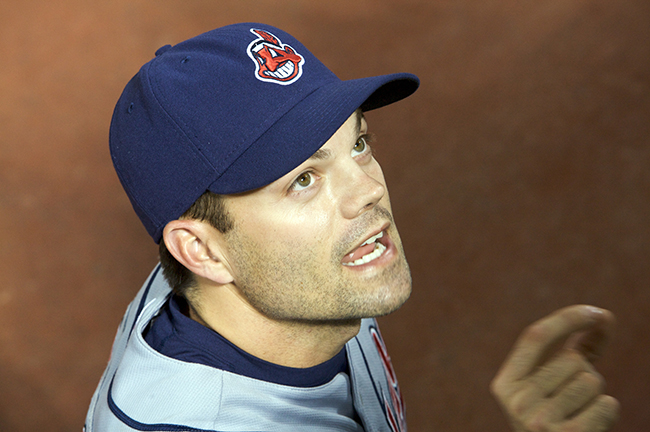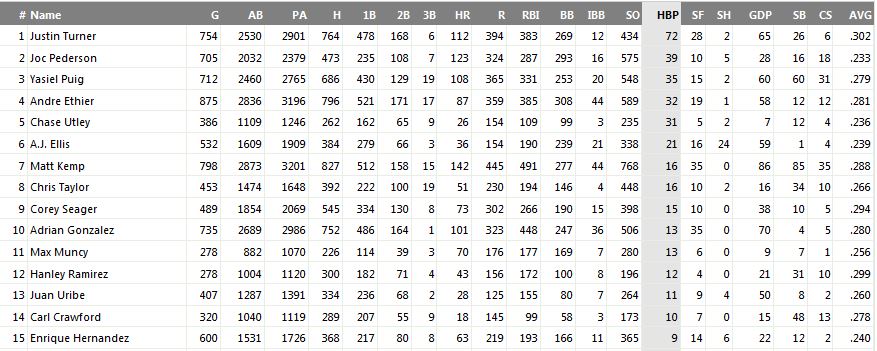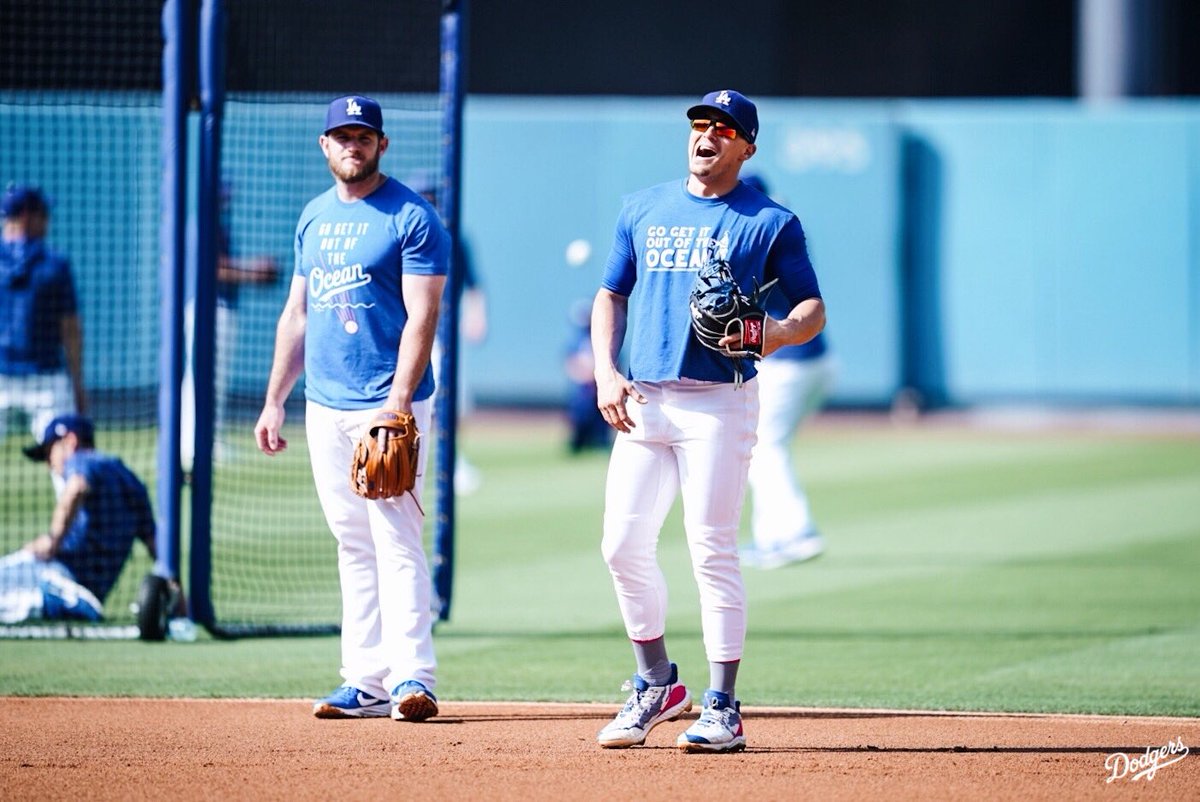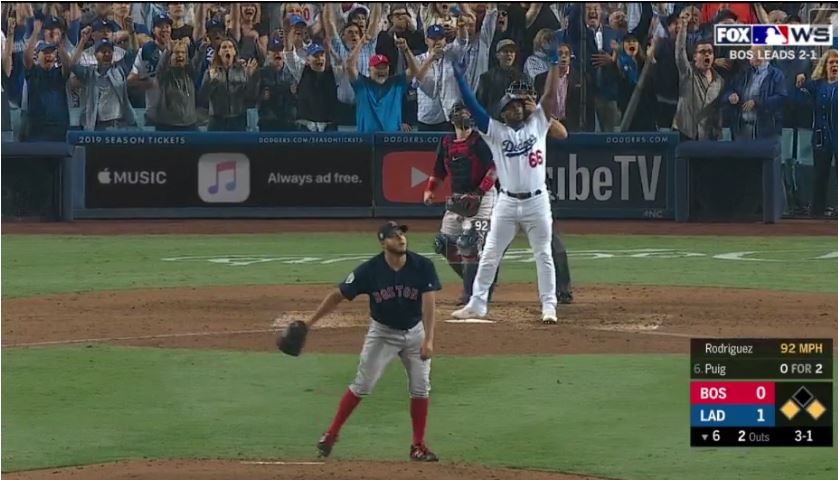For just my fourth post on here, I am going to see if I can upset some people with my opinion of the best Dodgers of the past decade. Before we get started on the franchise’s all-decade team, I will admit I leaned heavily onto FanGraphs’ WAR while also making some rather liberal decisions with who I placed at each position.
Some of these are pretty obvious while others were a struggle to either narrow down or even select one option (I think the position I am talking about is pretty obvious). With that said, I’ll get to it. This ended up being longer than I expected as I spent enough time looking through all these stats, I figured I might as well throw them into here.
CATCHER
Far and away the leader in WAR at the position (19.7 to 5.4 for second during the decade), Yasmani Grandal’s four seasons as a Dodger included 3,875 1/3 innings at catcher. In 1,883 PAs, Grandal slashed a .238/.337/.453/.790 line that led to a 116 wRC+.
Obviously his postseason numbers as a Dodger are going to drag down the opinion of him, and rightfully so. They were, in a word, abysmal. Slashing a .107/.220/.200/.420 with just 8 hits in 75 at-bats, the only thing Grandal did of much use was walk (16 times in 92 PAs) only for that to be offset by his 35 strikeouts during the stretch of 32 games.
However, with all of that said Grandal ranked second on FanGraphs’ WAR for the decade among Dodger batters (and tied for 14th across all of baseball) thanks, of course, to his defense. Despite going without a Gold Glove during his four years in Los Angeles, Grandal finished first in Baseball Prospectus’ adjusted Fielding Runs Above Average and Framing Runs in 2015, second in both categories in 2016, fourth in both for 2017 and back to first in both in 2018.
The Dodgers’ catchers for the decade are pretty ugly after the ones people hate. pic.twitter.com/owGaEGQyhh
— Cody Bashore (@Cody_Bashore) December 3, 2019
FIRST BASE
Cody Bellinger had to go somewhere and as you will see with the crowded outfield coming up, first base really was the best option. There’s an obvious omission as a result, and I will get to that below.
First, let’s take a look at Bellinger. With a 140 wRC+ through his three years in the majors, Bellinger ranks fourth among Dodgers with at least 1,000 PAs. Of the three above him, Hanley Ramirez (1,120 PAs) and Max Muncy (1,070 PAs) are well behind Bellinger’s 1,840 PAs and are barely ahead at 147 and 146 wRC+ respectively. The other you’ll see on this list shortly and is the clear cut offensive player of the decade for the Dodgers.
At 15.4 WAR, more than half of which came in 2019, Bellinger finished the decade sixth among batters in the category. While he spent most of the year in the outfield, Bellinger still has more innings (1,764) at first than he does in any specific outfield spot (RF leads the way with 948 1/3). With the Rookie of the Year award in 2017 and the Silver Slugger, Gold Glove and MVP in 2019, Bellinger closed out the decade by claiming a spot among the Dodgers’ best.
Now rather than point out only the good, I decided to take a look at some of the bad. As is the case with most Dodgers recently, Bellinger’s career slash line so far (.278/.368/.559/.927) is much better than the postseason (.178/.234/.326/.560). After starting out his postseason career with 10 hits in 36 at-bats, the 2017 World Series started a downward trend as Bellinger struck out 40 times in 107 PAs in the last five postseason series.
SECOND BASE
Yeah, I clearly cheated here. Second base was an absolute shitshow for most of the decade.
For the record, I did not spend the hours trying to figure out which mediocre player performed the best when playing only second base. To my current knowledge, FanGraphs does not split PAs made by players at a specific position, instead listing all stats a player accounted for under the position if they are listed as at it. Example: Kiké Hernandez is listed as 2B/OF, so all of his career numbers show up when searching for second base during the decade.
With that said, 16 players listed as second baseman reached at least 100 PAs for the Dodgers since 2010. A grand total of three have a wRC+ at or above 100. Max Muncy of course is the leader there at 146 and a position-best 10.0 WAR. The other two? Let’s go back to 2010 and revisit the Dodger tenures of Blake DeWitt and Jamey Carroll.

DeWitt played in just 82 games with 292 PAs with a 101 wRC+ in 2010 before being traded as part of a package to the Cubs for an actual downgrade in Ryan Theriot and Ted Lilly. Carroll reached, and I seriously can’t comprehend this, 924 PAs and a 103 wRC+ in 2010 and 2011 at 36 and 37 years old respectively. Carroll’s 4.4 WAR in those two seasons edged out Mark Ellis (3.8 WAR across 944 PAs in 2012-13) and sadly Chase Utley (3.6 WAR across 1,246 PAs from 2015-18).
I’m aware of Dee Gordon’s sell-high 2014 season included 3.6 WAR in 2014, but I decided Muncy’s 611 1/3 innings at second base was enough for me to throw him in here given just how much better he was than anyone else at the plate (and honestly, who cares? This isn’t a very serious post). Hernandez deserves some credit for his 7.3 WAR and 99 wRC+ since joining the Dodgers as a part of the Gordon trade, and he spent 1,014 innings at second in the past five years. But if I am going to cheat anyway, it might as well be Muncy and that aforementioned 10.0 WAR, which is 10th among batters in the decade. Plus, Muncy gave us this moment, which I think counts for something.
THIRD BASE
After spending more words than needed mocking just how bad the rotating cast of supremely replacement level humans the Dodgers employed at second base, third base is as easy as any position.
Justin Turner’s 25.3 WAR is the best among all position players since joining the Dodgers as a minor league free agent in February 2014. His 141 wRC+ in 2,901 PAs, the fourth most of the decade, is easily the best among players who have been with the organization as long as he has. Slashing .302/.381/.506/.887 and playing 5,205.1 innings at third base in 754 games, Turner’s place in the franchise’s history will be interesting to look back on as the years pass.
Turner has 236 PAs in 54 career postseason games with the Dodgers, slashing .310/.411/.520/.931. With a 2.84 win probability added in his postseason career according to Baseball Reference, Turner actually ranks third all-time behind David Ortiz and Albert Pujols. The stat leans more heavily toward modern day players given the expansion of postseason play over the years, but nonetheless it is an impressive feat.
Side note: Having cringed as Turner was hit by a pitch more times than I could count, it seemed like he had been hit than any other Dodger I could remember recently. The numbers indeed backed up the feeling.

SHORTSTOP
Trailing only Turner and Grandal in batter WAR through the decade, a pair of 6+ win seasons for Corey Seager has him third at 18.2. While Tommy John surgery robbed Seager of nearly all of the 2018 season and 2019 was a clear step below, it might be easy to forget just how great he was in 2016 and 2017.
Third in MVP voting, and Rookie of the Year winner, with a 6.9 WAR and 136 wRC+ 2016 season, Seager followed up with 6.0 WAR and 127 wRC+ in 2017 (winning a Silver Slugger each time). In total, Seager slashed .294/.362/.491/.853 across his five seasons and 2,069 PAs while doing so with better defense in 4003 innings than most likely expected from him at shortstop.
Seager has only played 489 games with the Dodgers thanks to losing most of 2018 due to injury, putting him just ahead of Chris Taylor’s 453 (really, that many already) and actually behind A.J. Ellis’ 532. Turning 26 in April, Seager seems like he has plenty more to offer going forward. An incredibly simplistic look at Seager’s 2019 season shows a few things that don’t look entirely different to that 2016 season, but that’s probably a post for another time.
LEFT FIELD
Another clear manipulation of positions, I felt compelled to get the Dodgers’ leader in games played (875) and runner-up in PAs (3,196) onto the team. A few of Andre Ethier’s best statistical seasons and his line Silver Slugger get left out of these numbers, as they came in 2009.
Obviously, much of Ethier’s production came in right field where he played 4,633 2/3 innings across seven seasons. Another 1,162 1/3 came in center field and only 568 2/3 came in left, but All-Star games don’t care so neither do I.
An All-Star in both 2010 and 2011, the same year he won a Gold Glove, Ethier put up three straight 3+ win seasons early in the decade. After totaling 3.0 in 2011 and 2012, a career-best 3.4 came in 2013. That seemed odd based on his offensive numbers, but FanGraphs’ defensive metrics seemed to like Ethier a lot more after 2010.
Across the seven seasons he played for the Dodgers in the decade, though 2016 and 2017 combined for just 64 PAs, Ethier slashed .281/.356/.445/.801 with a 122 wRC+. Granted Ethier’s extreme splits left him with a career wRC+ of 73 in 1,249 PAs against lefties, but a 139 wRC+ in 3,551 PAs against righties means it still wasn’t as significant of a split as the guy I am probably leaving out for him. Plus, this decade gave us one of the funniest, at least in my opinion, giveaways I can remember that was narrated by Vin Scully.
CENTER FIELD
Thanks to his 2018 return, Matt Kemp stole the top spot for PAs in the decade from Ethier, edging him by five with 3,201 while playing in 798 games (second to Ethier).
Putting together what probably should have been an MVP season in 2011, Kemp’s 8.3 WAR year carries much of the weight of his production in the decade. Ranking fourth among Dodgers at 17.2 WAR on Fangraphs, Kemp’s defense sapped some of his value in a few seasons.
Regardless, the .324/.399/.586/.986 slash line and 168 wRC+ of 2011 aided a .288/.350/.502/.852 and 134 wRC+ in total from 2010-14 and 2018. The one-year reunion went well overall in 2018, with Kemp hitting .290/.338/.481/.818 and 122 wRC+, adding an extra 1.6 WAR to his decade total with the team. Even without the extra season, Kemp would have landed on this list. In total, Kemp spent 4539.1 innings in center for the Dodgers during the decade.
Like Ethier, Kemp lost two of his top four career seasons to the decade’s cutoff, as a 3.3 WAR season came in 2008 and a 4.9 season in 2009. Even without the two seasons, Kemp led all Dodgers in hits (827), homers (142), RBIs (491), runs (445) during the 2010s while just one player (Dee Gordon obviously) stole more bases than his 85.
RIGHT FIELD
Having been lucky enough to be in the stands for Yasiel Puig’s debut on June 3, 2013, I was pretty confident I would find a way to put Puig on the team and his numbers back it up.
Puig finished the 2010s fifth in WAR (16.7) while his 129 wRC+ in 2,765 PAs is sixth among players with at least 1,000 PAs. Much of the production came from his first two seasons, with Puig amassing 3.9 WAR in 104 games during 2013 and another 5.5 in 148 games during 2014.
While Puig’s antics on and off the field wore thin at times for the Dodgers, his final year as a Dodger effectively matched what his career averaged out to. Slashing .267/.327/.494/.820 with a 123 wRC+ in 2018, the numbers closely matched his .279/.353/.478//831 and 129 wRC+ spanning his six years in total as a Dodger.
With so much time, energy and discussion dedicated to Puig during the decade, it is hard to think of the team without him. And for a team filled with so many disappointing postseason players, Puig’s playoff line of 280/.351/.429/.780 across 58 games and 202 PAs is actually a welcome sight.
And while it was lost in the depressing result of both the game and series, Puig’s three-run shot off of Eduardo Rodriguez and resulting bat flip in Game Four of the 2018 World Series is a moment I won’t forget.
HONORABLE MENTIONS
The most glaring omission from above is probably Adrian Gonzalez, who fell victim to both Cody Bellinger’s incredible rise from this past season, as well ass the Dodgers’ impressive list of outfielders who spent considerable time with the franchise.
Gonzalez does deserve recognition for his role in helping turn the franchise around after arriving from Boston in August 2012. (Side note: Looking through dates on some of these things, I realized this trade occurred just a few days before Kemp smashed into the Coors Field wall.)
Gonzalez made just one all-star game (2015) for the Dodgers, but did finish seventh in the MVP voting while winning a Silver Slugger and Gold Glove in 2014. Playing in Los Angeles from that 2012 trade until 2017, Gonzales best run came between 2013 and 2015. In all three seasons he produced consistent numbers with wRC+ totals of 124, 129 and 129 respectively. Similarly his OPS rose from .803 to .817 and finally .830, but the drop off severely hurt Gonzalez overall totals.
Gonzalez’s 9.9 WAR as a Dodger already trails Muncy while ranking just ahead of Taylor’s 9.5. Finishing with a slash line of .280/.339/.454/.793 and a 118 wRC+ in 2,986 PAs, Gonzalez comes in behind everyone above except Grandal, as well as the next two I’ll mention.
Second in home runs during the decade, Joc Pederson’s 123 is one of many ways he topped Gonzalez. In his 705 games and 2,379 PAs, Pederson has slashed .233/.339/.474/.813 with a 120 wRC+.
Virtually all of Pederson’s production has come against right-handed pitchers (131 wRC+ in 1.696 PAs vs. a 57 wRC+ in 336 PAs against lefties), but the 13.1 WAR still ranks 8th among batters in the decade. Like Puig, Pederson fell down to about league average at one point, but has mostly hung around the 125 wRC+ range in three of the past four years. Also like Puig, Pederson’s postseason line of .239/.326/.487/.813 is well above what some of his teammates have done.
Puig and Ethier really did just edge Pederson for spots above thanks to their less drastic platoon splits during their time with the Dodgers.
In just 1,120 PAs with the Dodgers after being traded from the Marlins on July 25, 2012, Hanley Ramriez finished ninth among batters with 10.2 WAR in his two and a half seasons. Slashing .299/.368/.506/.874 in just 278 games, Ramriez finished his short time as a Dodger with a 147 wRC+, beating out every other player in the statistical category.
While all of that is impressive, Ramirez’s biggest contribution may have been how well he performed in his 13 playoff games for the Dodgers. Slashing .356/.393/.578/.971 in his three series, including one while playing with a broken rib, Ramirez came up with 16 hits, including five doubles, a triple and a home run in 45 at-bats.
It didn’t last long, and he never truly duplicated it with the Red Sox, but Ramirez made an impact in his short tenure.
——
Next Up: Pitchers Of The Decade
 Dodgers Digest Los Angeles Dodgers Baseball Blog
Dodgers Digest Los Angeles Dodgers Baseball Blog



